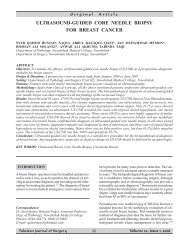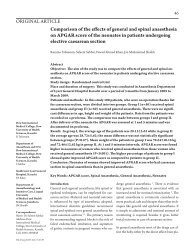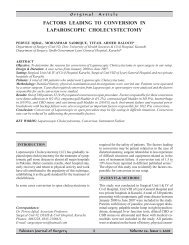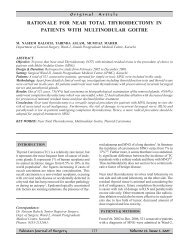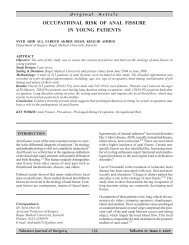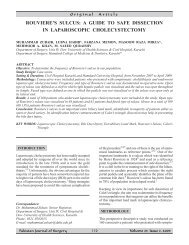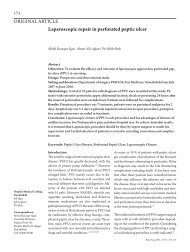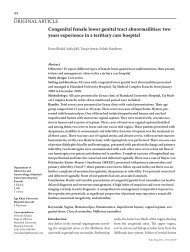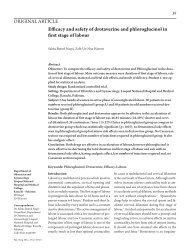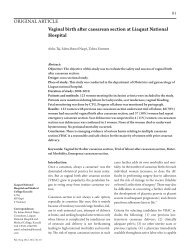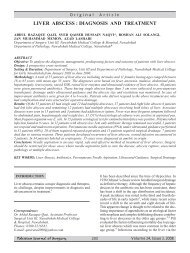Yag laser capsulotomy review of 500 cases at
Yag laser capsulotomy review of 500 cases at
Yag laser capsulotomy review of 500 cases at
Create successful ePaper yourself
Turn your PDF publications into a flip-book with our unique Google optimized e-Paper software.
INTRODUCTIONExtra capsular surgery and phacoemulsific<strong>at</strong>ion is acommon procedure carried out on a regular basis byevery ophthalmologist. One <strong>of</strong> the most common complic<strong>at</strong>ionis posterior capsule opacific<strong>at</strong>ion. 1 The posteriorcapsule opacific<strong>at</strong>ion (PCO) is more earlier in onset inyounger p<strong>at</strong>ient. 2 Nd <strong>Yag</strong> Laser has completely replacedsurgical <strong>capsulotomy</strong>. 3 Although simple and convenientthis procedure is associ<strong>at</strong>ed with complic<strong>at</strong>ion like,transient rise <strong>of</strong> intraocular pressure 4-6 , cystoid macularedema 6-8 , corneal endothelial damage 5-9 , macular hole 10 ,retinal detachment 1 and intraocular lens damage. Theauthors experience <strong>of</strong> <strong>500</strong> <strong>cases</strong> <strong>of</strong> YAG Laser Capsulotomyin last 15 years is presented here.This study is designed to find out different types <strong>of</strong>PCO, time interval between surgery and development<strong>of</strong> visually evident PCO and visual out come <strong>of</strong> YAG<strong>laser</strong> <strong>capsulotomy</strong>.METHODOLOGYThe study was conducted between 1993 to 2008 in theDepartment <strong>of</strong> Ophthalmology Unit I, Dow MedicalCollege and Civil Hospital, Karachi. The p<strong>at</strong>ient wereoper<strong>at</strong>ed for extra capsular c<strong>at</strong>aract extraction and phacoemulsific<strong>at</strong>ionwere included in the study, a specificallydesign performa was used for collection <strong>of</strong> d<strong>at</strong>a.The p<strong>at</strong>ients were thoroughly worked up in Out P<strong>at</strong>ientDepartment (OPD) starting from visual acuity recording,slit lamp examin<strong>at</strong>ion, intraocular pressure recording,fundoscopy. For YAG <strong>laser</strong> we used four point NEODYMIN YAG <strong>laser</strong>. After YAG, p<strong>at</strong>ient were given mildsteroid like flourome-thalone and p<strong>at</strong>ient were seenafter one hour for raised Intra Ocular Pressure (IOP)and advised to <strong>at</strong>tend OPD on second day and werefollowed up with regular visit if their was a need.RESULTSThree hundred and fifty p<strong>at</strong>ients were male (70%) andone hundred and fifty were females 30% average agewas fifty years ranging from 20 to 80 years. Of the five
hundred eyes four fifty (90%) had implanted posteriorchamber IOL, while fifty (10%) were aphakic. The timeperiod between surgery and YAG <strong>laser</strong> was between 6months to 12 years (Table I).Type <strong>of</strong> posterior capsule opacific<strong>at</strong>ion in this study isshown in Table II. The average pulse energy was 7.8milli joules ranging from 6.5 to 13 milli-joule energywas single pulse and number <strong>of</strong> shots were on an average16 raging form 10 to 50 shots. The result <strong>of</strong> pre-<strong>laser</strong>visual acuity and post <strong>laser</strong> visual acuity is comparedin Table III. There was no improvement in visual acuityin 70 p<strong>at</strong>ients in whom retinal problem was noticedafter Nd YAG <strong>laser</strong> <strong>capsulotomy</strong>, Diabetic retinop<strong>at</strong>hyseen in 30 p<strong>at</strong>ients, ARMD was noticed in 20 p<strong>at</strong>ientswhile 10 p<strong>at</strong>ients showed traum<strong>at</strong>ic maculop<strong>at</strong>hy, andanother 10 showed central retinal vein occlusion. Complic<strong>at</strong>ionassoci<strong>at</strong>ed with <strong>laser</strong> were shown in Table IV.DISCUSSIONAdvancement in c<strong>at</strong>aract surgery and new developmentslike phaco-emulsific<strong>at</strong>ion opacific<strong>at</strong>ion <strong>of</strong> posteriorcapsule has become one <strong>of</strong> the commonest cause <strong>of</strong>decreased vision after c<strong>at</strong>aract surgery. 1 In this studyout <strong>of</strong> five hundred p<strong>at</strong>ient 350 were male (70%) and150 were female (30%) Hasan reported 60% male and40% female in their study. 3 Opacific<strong>at</strong>ion <strong>of</strong> posteriorcapsule is more acceler<strong>at</strong>ed in children as observed inthe current study and similar results were seen in thed<strong>at</strong>a presented by Kundi 9 who showed 92% PCO inchildren. ND YAG <strong>laser</strong> average <strong>capsulotomy</strong> in thisstudy was 23 months which is some wh<strong>at</strong> different fromthe study by Hasan who showed <strong>capsulotomy</strong> <strong>at</strong> 2.49years. 3 Capsular fibrosis was predominant cause <strong>of</strong>PCO in this study as was in Hasan’s research showingElsching pearls was the commonest cause. 3Dram<strong>at</strong>ic improvement in visual acuity was seen afterYAG <strong>laser</strong> and 60% recorded visual acuity was 6/18 orbetter, no deterior<strong>at</strong>ion was seen. In the study by Panezai13 pre-<strong>laser</strong> hand movement vision improved to 6/36and 6/18 pre-<strong>laser</strong> vision improved to 6/6 complic<strong>at</strong>ionsin the present study were raised IOP, damage to IOL,disruption <strong>of</strong> anterior vitreous phase, cystoid macularedema which are well recognized complic<strong>at</strong>ions andhave been reported by a number <strong>of</strong> authors. 8-11,20,22CONCLUSIONThe PCO is a common complic<strong>at</strong>ion <strong>of</strong> c<strong>at</strong>aract surgeryND YAG <strong>laser</strong> <strong>capsulotomy</strong> is a very beneficial OPDprocedure in this study group the indic<strong>at</strong>ion were opticalbut it can be performed for therapeutic purpose.
REFERENCES1. Schauumberg D A, Dana M R. Christen W G. Systemicoverview <strong>of</strong> the incidence <strong>of</strong> posterior capsuleopacific<strong>at</strong>ion. Ophthalmology 1998; 105: 1213-21.2. Sunderraj P, Villada J R, Joyee P W. Glare testingin pseudophakes with posterior capsule opacific<strong>at</strong>ion.Eye 1992; 6: 411-3.3. Hasan K S, Adhi M I, Aziz M. Nd: YAG <strong>laser</strong> posterior<strong>capsulotomy</strong>. Pak Ophthalmol 1996; 12: 3-7.4. Clayman H M, Jaffe N S. Spontaneous enlargement<strong>of</strong> neodyminm: YAG posterior <strong>capsulotomy</strong> in aphakicand pseudophakic p<strong>at</strong>ients. J C<strong>at</strong>aract RefractSurg 1988; 14: 667-9.5. Aslam T M, Devlin H, Dhillon B. Use <strong>of</strong> Nd: YAG<strong>laser</strong> Capsulotomy. Sur Ophthal 2003; 48: 594-612.6. Terry A C, Stark W J, Maumenee A F. Neodymium-YAG <strong>laser</strong>. AN FDA report. Ophthalmology 1985;92: 209-12.7. Halepota F M, Dahri G R, Anjum N. Complic<strong>at</strong>ions<strong>of</strong> IOL implant<strong>at</strong>ion: A <strong>review</strong> <strong>of</strong> 400 <strong>cases</strong>. Pak JOphthalmol 1995; 11: 109-12.8. Nisar A, Durrani J. Causes <strong>of</strong> failure <strong>of</strong> visual rehabilit<strong>at</strong>ionin pseudphakic p<strong>at</strong>ients: A <strong>review</strong> <strong>of</strong> 100<strong>cases</strong>. Pak Journ Ophthalmol 1998; 14: 52-7.9. Kundi N K, Younas M. Nd-YAG Laser posterior<strong>capsulotomy</strong> J Med Sciences 1998; 8: 90-4.10. Wilkins M, Mcpherson R, Fergusson V. Visualrecovery under glare conditions following <strong>laser</strong><strong>capsulotomy</strong>. Eye 1996; 10: 117-20.11. L<strong>at</strong>if E, Aasi N A. Tre<strong>at</strong>ment <strong>of</strong> Postoper<strong>at</strong>ive pupillarymembrances with Nd-YAG <strong>laser</strong>. Pak JournOpthalmol 1996; 12: 8-12.12. Ge J, Wand M, Chiang R. Long-term effect <strong>of</strong> Nd:YAG <strong>laser</strong> posterior <strong>capsulotomy</strong> with Swiss <strong>laser</strong>.J C<strong>at</strong>aract Refract Surg 1986; 12: 150-3.13. Panezai M N, Shawani M A, Hameed K. Posteriorcapsular opacific<strong>at</strong>ion (PCO) and NdD: YAG Laser<strong>capsulotomy</strong> in Helpers Eye Hospital Quetta. PakJourn Ophthalmol 2004; 20: 115-8.14. Tayyab A A, Sahi T N, Ajmal M. Frequency <strong>of</strong> posteriorcapsular opacific<strong>at</strong>ion following PMMA vssilicon posterior chamber IOL implant<strong>at</strong>ion withphacoemulisific<strong>at</strong>ion. Pak Journ Ophthalmology2004; 20: 96-9.15. Magno B V, D<strong>at</strong>iles M B, Lasa M S. Evalu<strong>at</strong>ion <strong>of</strong>visual function following neodymium: YAG <strong>laser</strong>posterior <strong>capsulotomy</strong>. Ophthalmology 1997; 104:1287-93.16. Weiblinger R P. Review <strong>of</strong> the clinical liter<strong>at</strong>ureon the use <strong>of</strong> the Nd YAG <strong>laser</strong> for posterior <strong>capsulotomy</strong>.J C<strong>at</strong>aract Refract Surg 1986; 12: 162-70.17. Wilhelmus K R, Emery J M. Posterior capsule opacific<strong>at</strong>ionfollowing phacoemulsific<strong>at</strong>ion. OphthalSurg 1980; 11:264-7.18. B<strong>at</strong>h P E, Fankhauser F. Long-term results <strong>of</strong>Nd:YAG <strong>laser</strong> posterior <strong>capsulotomy</strong> with SwissLaser. J C<strong>at</strong>aract Refract Surg 1986; 12: 150-3.19. Krauss J M, Puliafito C A, Miglior S. Vitreouschanges after neodymium-YAG <strong>laser</strong> photodisruption.Arch Ophthalmol 1995; 113: 645-52.20. Trinavar<strong>at</strong> A, Atchaneeyasakul L, UdompunturakS. Neodymium: YAG <strong>laser</strong> damage threshold <strong>of</strong>foldable intraocular lenses. J C<strong>at</strong>aract Refract Surg.2001; 27: 775-80.21. Smith R T, Moscoso W F, Trokel S. The barrierfunction in neodymium-YAG <strong>laser</strong> damage threshold<strong>of</strong> foldable intraocular lenses. J C<strong>at</strong>aract RefractSurg 2001; 27: 775-80.22. Newland T J, Mc Dermott M L, Eliott D. Experimentalneodymium YAG <strong>laser</strong> damage to acrylic,polymethylmethacryl<strong>at</strong>e and silicone intraocularlens m<strong>at</strong>erials. Journ C<strong>at</strong>aract Refract Surg 1999;25: 72-6.



